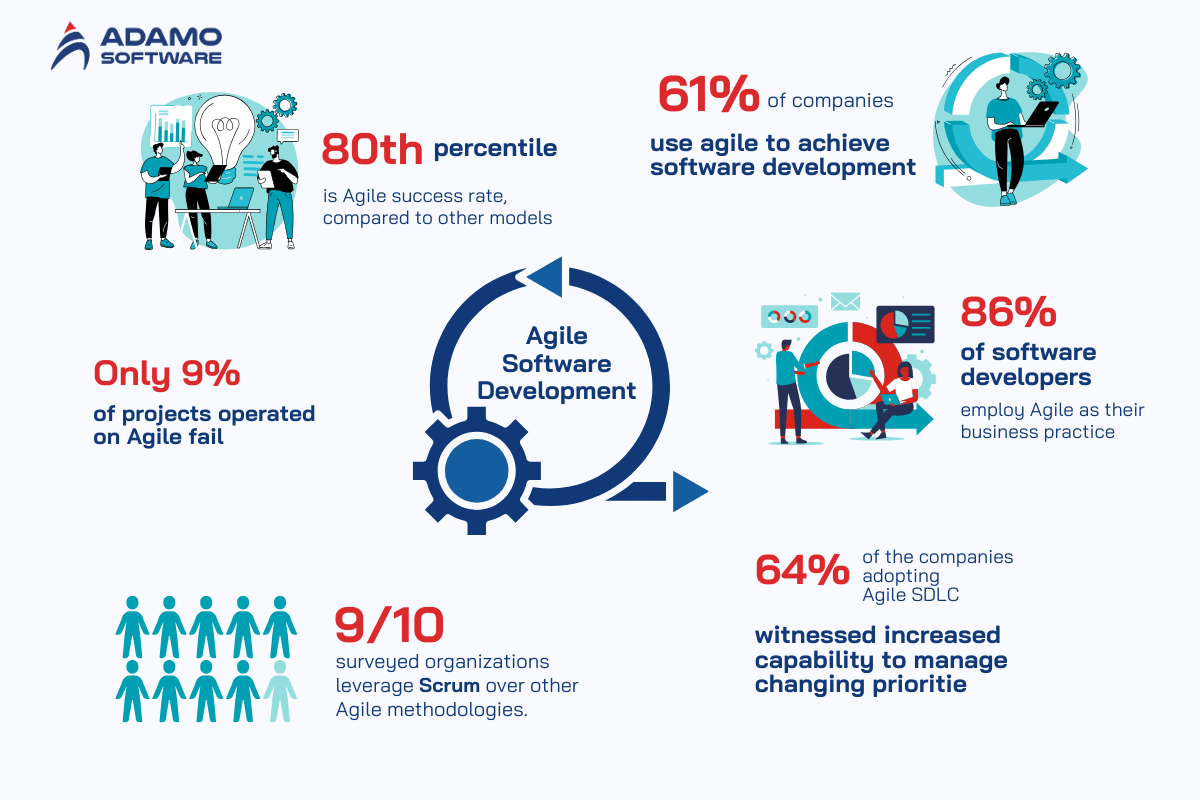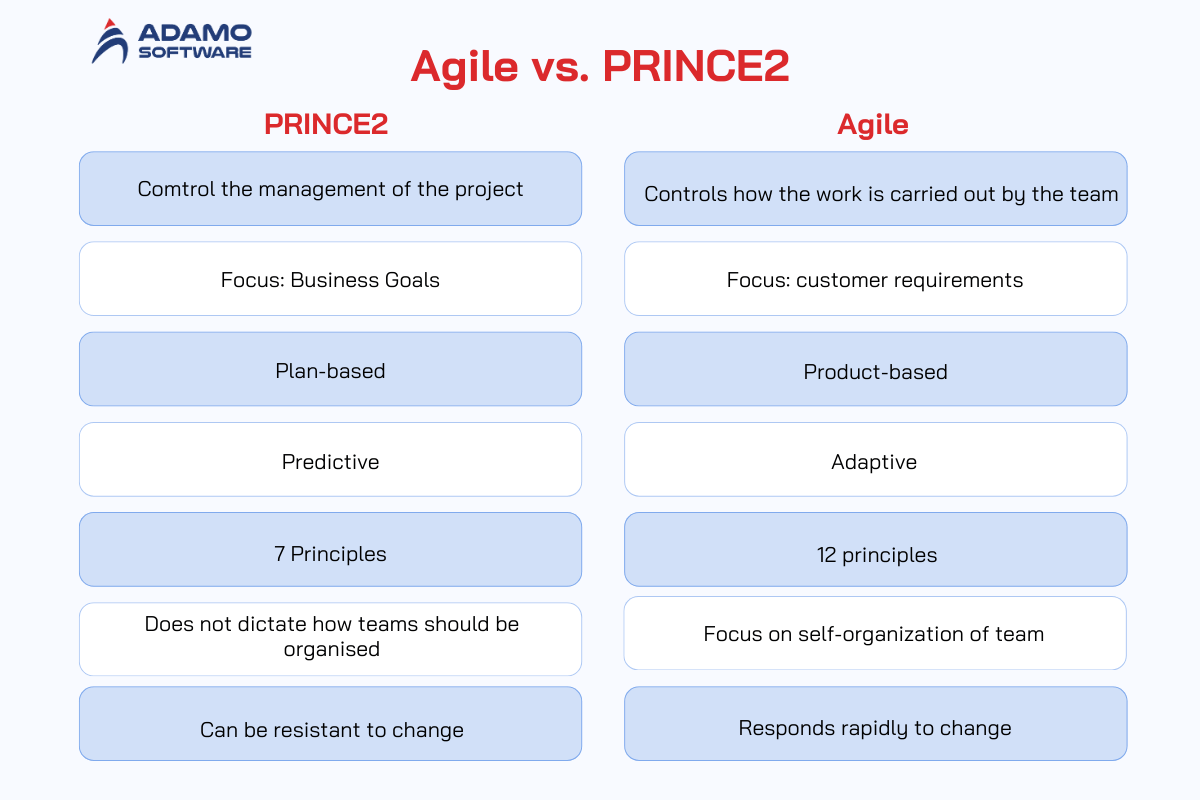Top 12 Benefits of Agile Methodology for Software Development

In today’s fast-paced and dynamic world, traditional development methods can be slow and inflexible. That’s why the Agile method is now preferred by many companies. This popular project management approach offers a collaborative way to build software that best suits your needs.
This article will dive into the top 12 benefits of Agile methodology, explore its advantages over traditional methods, as well as the challenges you might face when adopting this model.
I. What is Agile Model?
Agile, a term comprising the best practices as specified in the Agile Manifesto, puts emphasis on collaboration, adaptability, and self-organizing teams. It disregards the one-size-fits-all approach and prioritizes timely responses to change and uncertainty. The Agile Alliance positions Agile as a core mindset for navigating unpredictability as it helps you to:
– Embrace uncertainty.
– Develop a potential solution and test it.
– Gather feedback.
– Adapt based on the feedback.
The benefits of Agile methodology lie in the framework of practices, techniques, and procedures a team sets for a specific project or situation. While the methods may vary for different teams with different projects, they all conform with the major Agile principles and values.
II. Why Agile Software Development is Popular?

The rapid rate of technological advancements in the 21st century has transformed the way we work across all industries. Nowadays, more and more companies adopt and embrace the benefits of Agile methodology, McKinsey & Company referred to this as “agility is catching fire”, which is enough to visualize how fast and popular the Agile model has become as a part of the software development process.
Software development teams were the first ones to apply this method, taking advantage of it to streamline projects and significantly shorten product launch cycles. Following this success, many other organizations are adopting Agile to improve their workflows and stay in the competition.
A recent study by Organize Agile on professionals across 19 countries showed that nearly half of all organizations have been using Agile for at least three years. It seems that the benefits of Agile methodology are so significant that Agile is now the new normal for many teams around the world.
So, what are the benefits of Agile methodology? Let’s have a look at the 12 most important advantages of the Agile method right down below.
Also read: What is Custom Software: Definition, Benefits, Types, Best Practices
III. Top 12 Benefits of Agile Development Methodology
1. Adaptability
One of the main benefits of Agile methodology is its adaptability. Unlike traditional inflexible approaches, Agile allows teams to be extremely flexible. This is made possible by working in short, iterative cycles known as “sprints”. These sprints enable constant and real-time feedback from stakeholders and end-users.
This continuous flow of information empowers the team to make corrections and changes quickly without bearing large additional costs or having to completely redo prior iterations. This agility ensures that the final product remains relevant and closely aligns with customers’ needs, even when they change with time.
2. Customer Satisfaction
Another important factor among the many benefits of Agile methodology is its impact on customer satisfaction. Traditional project management often only includes clients in the planning phase and not in the development phase. While one of the benefits of Agile methodology is that it does the opposite. By actively involving customers throughout the whole process of development, Agile helps form a collaborative environment, emphasizing transparency and open communication.
This allows customers to provide real-time feedback on features and functionality. When customers see their concerns being addressed quickly, they feel a sense of ownership over the project’s direction. This not only leads to a product that better meets their needs but also fosters a sense of trust and satisfaction.
3. Predictability
While often associated with flexibility, the surprising benefits of Agile methodology also lie in its predictability. While traditional project management approaches rely on lengthy planning, Agile breaks down work into short sprints. These sprints often last for two weeks, with project-based variations.
This structure offers several advantages for both project managers and clients. Since each sprint has a clear boundary, it would be much easier for the clients to monitor the team’s process and overall performance. This also allows project managers to effectively allocate resources and identify areas that might need additional support to work on improving them in time.
Furthermore, the shorter time frames of sprints can simplify the process of cost estimation. Instead of trying to predict expenses of a project for a whole year, companies can start with a budget estimation for just two weeks, making it more accurate and realistic. This enhanced predictability fosters better decision-making and helps keep projects on track – making these some important benefits of Agile methodology.
4. Enhance Communication
Its focus on clear, constant communication is also one of the benefits of Agile methodology. Daily scrum meetings within short sprints can be a 15-minute check-in session for the team. Here, members can share progress, discuss any problems they’re facing, and find the solutions together. This keeps everyone informed, aligned with the whole team, and able to address any issues that might arise.
Moreover, these open discussions foster a collaborative environment where everyone feels valued, leading to improved communication and overall project satisfaction.
5. Improve Final Product Quality
One of the key benefits of Agile methodology is its positive impact on the final product quality. Traditional methods can prioritize speed and efficiency over quality, which might lead to bugs or features that don’t solve users’ problems. Agile, however, does the opposite by integrating testing and feedback throughout the entire development process.
Here’s how these benefits both clients and the development team:

– Continuous improvement: Agile wins with short cycles. Each “sprint” ends with a review, incorporating user feedback to constantly improve the project. This process guarantees the production of a high-quality final product.
– Early detection of issues: Agile’s short sprints are like quality checkpoints. Frequent testing allows teams to early detect any bugs, preventing snowballing issues and ensuring a well-crafted final product.
– Focus on value: Agile keeps development focused on what matters: the user. By prioritizing user feedback, teams build features that deliver real value, ensuring a final product that meets user needs and expectations.
By prioritizing quality throughout the development lifecycle, the Agile method enables teams to deliver exceptional final products that are not only functional but also meet the needs of the user.
6. Risk Reduction
Reducing risks is also among the core benefits of Agile methodology. Agile’s short sprints allow developers to regularly assess progress throughout these intervals. This frequent check-in allows developers to monitor the project better and identify any potential issue from an early stage to take actions against it.
By resolving these minor problems before they snowball into bigger ones, Agile fosters a proactive approach to risk management. The ability to address potential challenges timely will help teams to reduce their impact on the project timeline and budget. This in turn reduces the overall risk associated with the project and increases the likelihood of a successful outcome.
7. Resources Optimization
Agile offers significant benefits in resource optimization. As mentioned above, one of the key benefits of Agile methodology is its predictability, which helps teams to effectively anticipate the cost for each project and hence optimize its financial resources. Teams can also review both development work and processes, enabling any adjustments based on changing needs, preventing wasted time and resources on unproductive procedures. This is a crucial part of the benefits of Agile methodology.
By aligning budget management with sprints, resource allocation directly reflects project structure, limiting unnecessary spending for each phase of the whole process.
8. Constant Improvement
One of the benefits of Agile methodology that makes it attractive is its focus on continuous improvement. One of its core principles is self-reflection, achieved through its sprints. These sprints allow teams to learn from their experiences within each iteration. Successes and challenges are reviewed, creating room for improvement for the next sprint. This circle of feedback and adjustments ensures the project keeps improving and getting better.
Furthermore, as we’ve discussed above, Agile fosters collaboration through open communication and teamwork. This exchange of ideas and shared learning fuels innovation and problem-solving, ultimately leading to a more effective development process.
9. Relevant Metrics
Unlike traditional, plan-driven methodologies where success largely depends on being stuck with that predetermined plan, Agile’s success is brought about by its focus on relevant metrics. The benefits of Agile methodology are the frequent measurement cycles fueled by regular team reviews. This provides a more accurate, real-time picture of progress.
Agile metrics go beyond simply measuring the “what” (completed tasks) but also take into account the “how” (team dynamics and workflow efficiency). This thorough approach empowers continuous improvement and ultimately leads to higher quality work.
10. Higher Job Satisfaction
Agile goes beyond just efficient processes; it fosters a work environment that boosts developer satisfaction. This is another key point among the various benefits of Agile methodology. Agile’s approach is said to be “humanizing the work”, placing ownership of development decisions directly in the hands of those building the software, rather than through layers of management.
This empowers teams to respond to customer needs in real-time with their expertise, fostering a greater sense of value and accomplishment in the software they create. Agile also fosters inherent creativity in software development. This creativity is achieved by allowing developers to approach problems with ownership and ingenuity.
11. Encourage Cross-Functional Collaboration
Another major key factor of the many benefits of Agile methodology is its emphasis on cross-functional collaboration. Agile breaks down tasks between departments. Instead of the traditional task assignment process where designers pass ideas to engineers, then to testers, and so on, Agile empowers teams to self-organize.
These cross-functional teams can combine diverse skill sets, allowing them to tackle all aspects of a project simultaneously. This fosters better communication, problem-solving, and ultimately, a more cohesive final product.
12. Well-defined Paths to Success
The last point to discuss regarding the benefits of Agile methodology is that it offers a well-defined path to success. Unlike pre-planned and inflexible approaches, Agile thrives on continuous monitoring and adaptation. This core characteristic allows projects to adjust based on real-time feedback from customers and internal stakeholders. Regular reflection and course correction ensure alignment with evolving needs, ultimately leading to a more successful outcome.
The “success” of Agile implementation can be objectively measured by its results. Companies that demonstrably deliver high-quality products while adapting to change are truly enjoying the true competitive benefits of Agile methodology.
IV. Advantages of Agile Project Management Over Others
1. Agile vs. Waterfall Project Management

Waterfall, a traditional project management method, follows a rigid, step-by-step approach where each task is completed in sequence. While this structure can be beneficial for long-term projects like construction, it may cause a lot of challenges in fast-paced environments like software development where client needs and requirements can evolve rapidly.
This is where the benefits of Agile methodology truly shine. Unlike Waterfall’s linear path, Agile thrives on flexibility and adaptation. A prime example is the media giant NPR. They transitioned from Waterfall to Agile to avoid situations where the final product significantly differed from the initial plan. Since their project vision wasn’t fully formed, the inflexibility of Waterfall’s predefined plan wasn’t ideal. Agile’s adaptability provided them with the flexibility they needed to navigate the project’s uncertainties.
2. Agile vs. Lean
Leaning towards efficiency, the Lean methodology eliminates unnecessary waste to streamline processes. While both Lean and Agile share a focus on customer satisfaction and rapid delivery, Agile might be better in terms of readily implementable structure.
Here’s where the benefits of Agile methodology matter. Agile, though known for its flexibility compared to traditional methods, still offers a valuable level of structured organization. Defined roles, frequent meetings, and systematic reviews provide a framework that can be implemented easily.
On the other hand, Lean prioritizes cultural shifts within an organization. Its focus on abstract thinking can make it too confusing and potentially more challenging to put into practice compared to Agile’s versatile structure.
3. Agile vs. PRINCE2

PRINCE2 (Projects In Controlled Environments) and Agile are two popular project management methodologies, but they are designed for different needs. Agile methodology shines with its adaptability and focus on continuous delivery.
PRINCE2 utilizes product-based planning with a structured project board for high-level tasks. A dedicated project manager oversees day-to-day operations, making it well-suited for higher management seeking a clear, structured approach. However, it can lack the emphasis on rapid delivery that Agile prioritizes.
In contrast, Agile thrives in dynamic environments, which is one of the huge benefits of Agile methodology. It avoids the predictive, plan-based approach of PRINCE2. Instead, Agile teams focus on delivering functional software to customers in short, iterative sprints. Throughout each sprint, they gather user feedback to inform and refine the development process. This iterative approach allows Agile teams to be far more adaptable to evolving customer needs.
V. Challenges of Agile Methodology
All these benefits of Agile methodology, like many other methods, come with some drawbacks. While its core principles offer significant benefits, neglecting potential challenges can lead to unintended consequences.
One of the biggest challenges is uncertainty. Agile’s flexibility inherently makes it harder to accurately estimate project timelines, resource allocation, and overall effort required. This uncertainty can cause anxiety and lead to poor decision-making within teams.
Another factor to consider is increased commitment. Agile thrives on constant communication and collaboration. While this fosters a positive environment, it also demands more time and energy from everyone involved in the project.
The success of Agile depends on commitment from all stakeholders, developers and clients alike. A lack of ‘enthusiasm’ from any member of those parties can negatively impact project quality.
Agile’s focus on rapid development can sometimes come at the expense of detailed documentation. Tasks are often completed just-in-time, making it hard to have comprehensive documentation. This lack of thorough records can create misunderstandings and difficulties later in the project lifecycle.
Finally, the flexible nature of Agile can be a double-edged sword. While it allows for adaptation, it also presents a risk of projects deviating significantly or exceeding their initial scope. Agile teams need to be particularly mindful of staying on track to avoid these downsides.
VI. How Adamo Leverage Agile Software Development Method
At Adamo, we understand that traditional software development methods can be slow and inflexible. That’s why we leverage the benefits of Agile methodology to deliver exceptional results ranging from mobile to website development for our clients.

Our Agile approach breaks down projects into manageable sprints, allowing for rapid development and constant adaptation based on your feedback. This ensures we’re always building exactly what you need, keeping your project on track and minimizing wasted time and resources.
Here are some of the key benefits of choosing Adamo’s Agile development:
– Faster Time to Market: Get your software to market quicker with our iterative development cycles.
– Reduced Costs: Agile methodology helps us identify and eliminate project inefficiencies, leading to cost savings for you.
– Enhanced User Experience: Continuous feedback loops ensure your software delivers a superior user experience.
– Transparency & Collaboration: Stay informed throughout the entire development process with regular communication and clear milestones.
Ready to unlock the power of Agile for your next software project? Contact us today and let’s discuss how we can help your business reach the next levels.











